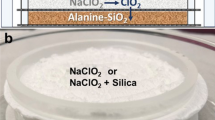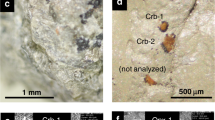Abstract
THE non-detection of organic compounds on Mars1 is interesting because there are at least two mechanisms that can produce a contemporary accumulation of these compounds on Mars—photochemical synthesis and meteoritic infall. The synthesis of organic compounds from carbon monoxide and water absorbed in inorganic matrices under UV irradiation and simulated martian conditions has been demonstrated1. By comparison, our Moon has a surface composition that is 1.1% carbonaceous chondrite, due to a meteoritic infall rate about three times less than that on Mars2. As much as 5% of carbonaceous chondrite material is organic3. Assuming a meteoritic influx rate three times that of the Moon, and a reasonable mixing rate with the martian regolith, organic constituents of carbonaceous chondrites should be diluted in the martian soil to concentrations detectable by the Viking gas chromatograph–mass spectrometer (GCMS)1. The results of the Viking GCMS experiments were, therefore, rather surprising. No organic molecules were present in the Viking GCMS samples above concentrations of parts per 109 (ref. 1). Mechanisms have been proposed in which peroxides, superoxides and ozonides formed under UV irradiation oxidise organic compounds4,5. Glow discharge was suggested as the ‘scavenger’ of martian organic matter6. Here, we propose an alternative mechanism for the destruction of organics on Mars—UV-stimulated catalytic oxidation. Our proposal differs from previous ones in that all conditions required for photocatalytic oxidation of organics—gaseous oxygen7, UV irradiation8, and titanium dioxide9,10—have been found to be present in the martian environment.
This is a preview of subscription content, access via your institution
Access options
Subscribe to this journal
Receive 51 print issues and online access
$199.00 per year
only $3.90 per issue
Buy this article
- Purchase on Springer Link
- Instant access to full article PDF
Prices may be subject to local taxes which are calculated during checkout
Similar content being viewed by others
References
Biemann, K. et al. J. geophys. Res. 82, 4641–4658 (1977).
Hartmann, W. K. Icarus 31, 260–276 (1977).
Hayes, J. M. Geochim. cosmochim. Acta 31, 1395–1440 (1967).
Oyama, V. I., Berdahl, B. J. & Carle, G. C. Nature 265, 110–114 (1977).
Ponnamperuma, C., Shimoyama, A., Yamada, M., Hobo, T. & Pal, R. Science 197, 455–457 (1977).
Mills, A. A. Nature 268, 614 (1977).
Owen, T. et al. J. geophys. Res. 82, 4635–4639 (1977).
Pang, K. & Hord, C. W. Icarus 18, 481–488 (1973).
Pang, K. & Ajello, J. M. Icarus 30, 63–74 (1977).
Toulmin, III, P. et al. J. geophys. Res. 82, 4625–4634 (1977).
Filimonov, V. N. Dokl. Akad. Nauk SSSR 154, 151–154 (1964).
McLintock, I. S. & Ritchie, M. Trans. Faraday Soc. 60, 1007–1016 (1964).
Formenti, M., Juillet, F., Meriaudeau, P., Teichner, S. J. & Vergnon, P. J. Colloid Interface Sci. 39, 79–89 (1972).
Bickley, R. I., Munuera, G. & Stone, F. S. J. Catal. 31, 398–407 (1973).
Formenti, M., Juillet, F., Teichner, S. J. Bull Soc. Chim. France 9–10, 1315–1319 (1976).
Formenti, M. et al. Vacuum Sci. Technol. 9, 947–952 (1971).
Pollack, J. B. et al. J. geophys. Res. 82, 4479–4496 (1977).
Author information
Authors and Affiliations
Rights and permissions
About this article
Cite this article
CHUN, S., PANG, K., CUTTS, J. et al. Photocatalytic oxidation of organic compounds on Mars. Nature 274, 875–876 (1978). https://doi.org/10.1038/274875a0
Received:
Accepted:
Issue Date:
DOI: https://doi.org/10.1038/274875a0
This article is cited by
-
The origin of methane and biomolecules from a CO2 cycle on terrestrial planets
Nature Astronomy (2017)
-
Chloromethane release from carbonaceous meteorite affords new insight into Mars lander findings
Scientific Reports (2014)
-
Ultraviolet-radiation-induced methane emissions from meteorites and the Martian atmosphere
Nature (2012)
-
Viking Biology Experiments: Lessons Learned and the Role of Ecology in Future Mars Life-Detection Experiments
Space Science Reviews (2008)
-
Organic materials in a martian meteorite
Nature (1989)
Comments
By submitting a comment you agree to abide by our Terms and Community Guidelines. If you find something abusive or that does not comply with our terms or guidelines please flag it as inappropriate.



